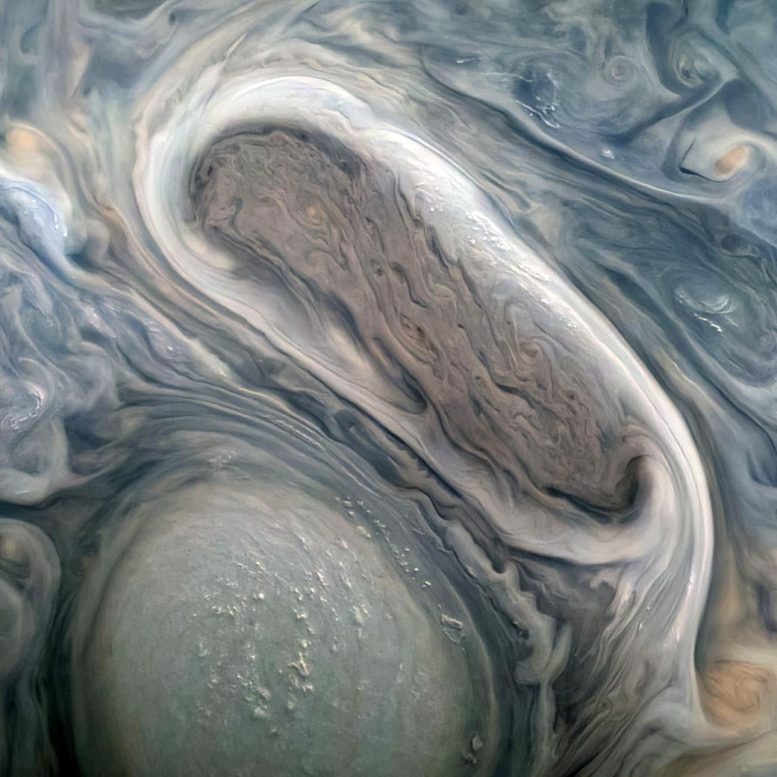
This JunoCam image shows two of Jupiter’s large rotating storms, captured on Juno’s 38th perijove pass, on November 29, 2021. Credit: NASA/JPL-Caltech/SwRI/MSSS Image processing: Kevin M. Gill CC BY
An audio track collected during Jupiter mission’s Ganymede flyby offers a dramatic ride-along. It is one of the highlights mission scientists shared in a briefing at American Geophysical Union Fall Meeting.
Sounds from a Ganymede flyby, magnetic fields, and remarkable comparisons between Jupiter and Earth’s oceans and atmospheres were discussed during a briefing today on NASA’s Juno mission to Jupiter at the American Geophysical Union Fall Meeting in New Orleans.
Juno Principal Investigator Scott Bolton of the Southwest Research Institute in San Antonio has debuted a 50-second audio track generated from data collected during the mission’s close flyby of the Jovian moon Ganymede on June 7, 2021. Juno’s Waves instrument, which tunes in to electric and magnetic radio waves produced in Jupiter’s magnetosphere, collected the data on those emissions. Their frequency was then shifted into the audio range to make the audio track.
“This soundtrack is just wild enough to make you feel as if you were riding along as Juno sails past Ganymede for the first time in more than two decades,” said Bolton. “If you listen closely, you can hear the abrupt change to higher frequencies around the midpoint of the recording, which represents entry into a different region in Ganymede’s magnetosphere.”
Radio emissions collected during Juno’s June 7, 2021, flyby of Jupiter’s moon Ganymede are presented here, both visually and in sound. Credit: NASA/JPL-Caltech/SwRI/Univ of Iowa
Detailed analysis and modeling of the Waves data are ongoing. “It is possible the change in the frequency shortly after closest approach is due to passing from the nightside to the dayside of Ganymede,” said William Kurth of the University of Iowa in Iowa City, lead co-investigator for the Waves investigation.
At the time of Juno’s closest approach to Ganymede – during the mission’s 34th trip around Jupiter – the spacecraft was within 645 miles (1,038 kilometers) of the moon’s surface and traveling at a relative velocity of 41,600 mph (67,000 kph).
Magnetic Jupiter
Jack Connerney from NASA’s Goddard Space Flight Center in Greenbelt, Maryland, is the lead investigator with Juno’s magnetometer and is the mission’s deputy principal investigator. His team has produced the most detailed map ever obtained of Jupiter’s magnetic field.
Compiled from data collected from 32 orbits during Juno’s prime mission, the map provides new insights into the gas giant’s mysterious Great Blue Spot, a magnetic anomaly at the planet’s equator. Juno data indicates that a change in the gas giant’s magnetic field has occurred during the spacecraft’s five years in orbit, and that the Great Blue Spot is drifting eastward at a speed of about 2 inches (4 centimeters) per second relative to the rest of Jupiter’s interior, lapping the planet in about 350 years.
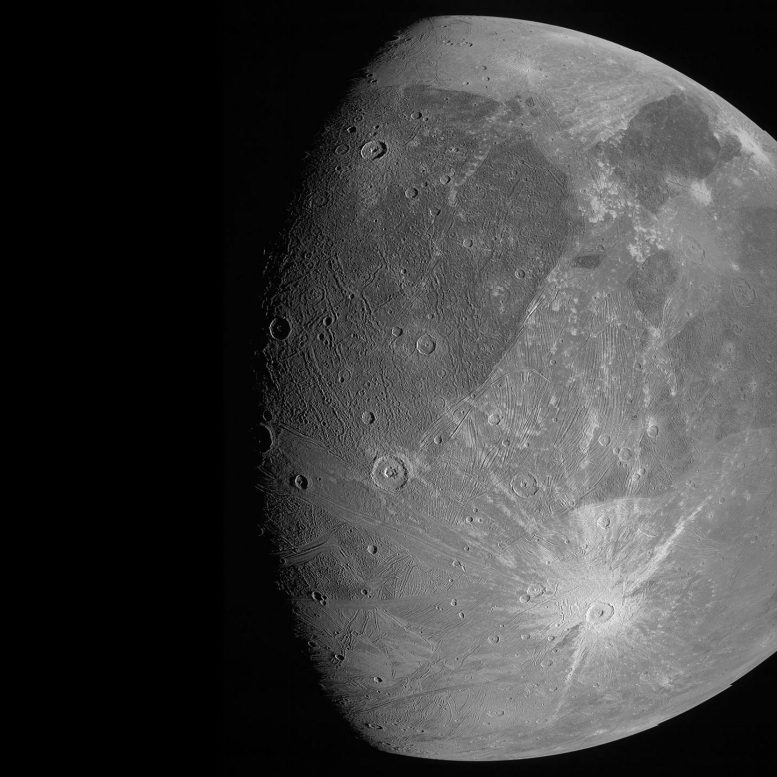
This image of the Jovian moon Ganymede was obtained by the JunoCam imager aboard NASA’s Juno spacecraft during its June 7, 2021, flyby of the icy moon. Credit: NASA/JPL-Caltech/SwRI/MSSS
In contrast, the Great Red Spot – the long-lived atmospheric anticyclone just south of Jupiter’s equator – is drifting westward at a relatively rapid clip, circling the planet in about four-and-a-half years.
In addition, the new map shows that Jupiter’s zonal winds (jet streams that run east to west and west to east, giving Jupiter’s its distinctive banded appearance) are pulling the Great Blue Spot apart. This means that the zonal winds measured on the surface of the planet reach deep into the planet’s interior.
The new magnetic field map also allows Juno scientists to make comparisons with Earth’s magnetic field. The data suggests to the team that dynamo action – the mechanism by which a celestial body generates a magnetic field – in Jupiter’s interior occurs in metallic hydrogen, beneath a layer expressing “helium rain.”
Data Juno collects during its extended mission may further unravel the mysteries of the dynamo effect not only at Jupiter but those of other planets, including Earth.
Earth’s Oceans, Jupiter’s Atmosphere
Lia Siegelman, a physical oceanographer and postdoctoral fellow at Scripps Institution of Oceanography at the University of California, San Diego, decided to study the dynamics of Jupiter’s atmosphere after noticing that the cyclones at Jupiter’s pole appear to share similarities with ocean vortices she studied during her time as a doctoral student.
“When I saw the richness of the turbulence around the Jovian cyclones, with all the filaments and smaller eddies, it reminded me of the turbulence you see in the ocean around eddies,” said Siegelman. “These are especially evident in high-resolution satellite images of vortices in Earth’s oceans that are revealed by plankton blooms that act as tracers of the flow.”
The simplified model of Jupiter’s pole shows that geometric patterns of vortices, like those observed on Jupiter, spontaneously emerge, and survive forever. This means that the basic geometrical configuration of the planet allows these intriguing structures to form.
Although Jupiter’s energy system is on a scale much larger than Earth’s, understanding the dynamics of the Jovian atmosphere could help us understand the physical mechanisms at play on our own planet.
Arming Perseus
The Juno team has also released its latest image of Jupiter’s faint dust ring, taken from inside the ring looking out by the spacecraft’s Stellar Reference Unit navigation camera. The brightest of the thin bands and neighboring dark regions scene in the image are linked to dust generated by two of Jupiter’s small moons, Metis and Adrastea. The image also captures the arm of the constellation Perseus.
“It is breathtaking that we can gaze at these familiar constellations from a spacecraft a half-billion miles away,” said Heidi Becker, lead co-investigator of Juno’s Stellar Reference Unit instrument at NASA’s Jet Propulsion Laboratory in Pasadena. “But everything looks pretty much the same as when we appreciate them from our backyards here on Earth. It’s an awe-inspiring reminder of how small we are and how much there is left to explore.”
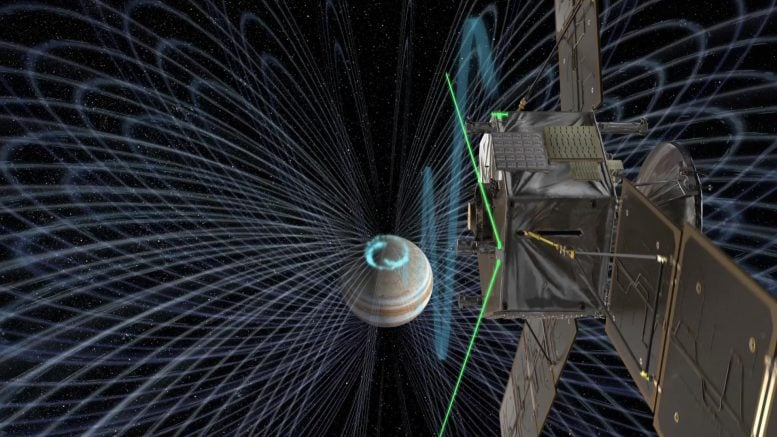
This artist’s rendering shows Juno above Jupiter’s north pole, with the auroras glowing brightly. Jupiter’s magnetic field surrounds the planet. A radio wave from the auroras is shown traveling past the spacecraft, where it is intercepted by the Waves investigation, whose sensors are highlighted in bright green. Credit: NASA
Juno Waves
The Waves instrument measures radio and plasma waves in Jupiter’s magnetosphere, helping us understand the interactions between the planet’s magnetic field, atmosphere, and magnetosphere. Waves also pays particular attention to activity associated with auroras.
Jupiter’s magnetosphere, an enormous bubble created by the planet’s magnetic field, traps plasma, an electrically charged gas. Activity within this plasma, which fills the magnetosphere, triggers waves that only an instrument like Waves can detect.
Because plasma conducts electricity, it behaves like a giant circuit, connecting one region with another. Activity on one end of the magnetosphere can therefore be felt somewhere else, allowing Juno to monitor processes occurring in this entire, giant region of space around Jupiter. Radio and plasma waves move through the space around all of the giant, outer planets, and previous missions have been equipped with similar instruments.
Juno’s Waves instrument consists of two sensors; one detects the electric component of radio and plasma waves, while the other is sensitive to just the magnetic component of plasma waves. The first sensor, called an electric dipole antenna, is a V-shaped antenna, four meters from tip to tip — similar to the rabbit-ear antennas that were once common on TVs. The magnetic antenna — called a magnetic search coil — consists of a coil of fine wire wrapped 10,000 times around a 6-inch-long (15-centimeter) core. The search coil measures magnetic fluctuations in the audio frequency range.
More About the Mission
JPL, a division of Caltech in Pasadena, California, manages the Juno mission for the principal investigator, Scott J. Bolton, of the Southwest Research Institute in San Antonio. Juno is part of NASA’s New Frontiers Program, which is managed at NASA’s Marshall Space Flight Center in Huntsville, Alabama, for the agency’s Science Mission Directorate in Washington. Lockheed Martin Space in Denver built and operates the spacecraft.


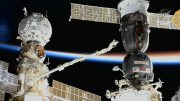
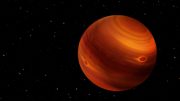

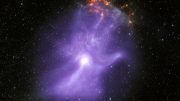

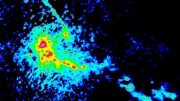

Babu G. Ranganathan*
(B.A. Bible/Biology)
JUST BECAUSE SCIENCE CAN EXPLAIN how an airplane works doesn’t mean that no one designed or made the airplane. And just because science can explain how life or the universe works doesn’t mean there was no Designer and Maker behind them.
Natural laws may explain how the order in the universe works and operates, but mere undirected natural laws cannot explain the origin of that order. Once you have a complete and living cell then the genetic code and biological machinery exist to direct the formation of more cells from raw materials such as amino acids and other chemicals, but how could life or the cell have naturally originated when no directing code and mechanisms existed in nature? Read my Internet article: HOW FORENSIC SCIENCE REFUTES ATHEISM.
WHAT IS SCIENCE? Science simply is knowledge based on observation. No human observed the universe coming by chance or by design, by creation or by evolution. These are positions of faith. The issue is which faith the scientific evidence best supports.
SCIENCE SHOWS THAT THE UNIVERSE CANNOT BE ETERNAL because it could not have sustained itself eternally due to the law of entropy (increasing and irreversible net energy decay, even in an open system). Even a hypothetical oscillating universe could not continue to oscillate eternally! Einstein’s General Theory of Relativity shows that space, matter, and time all are physical and all had a beginning. Space even produces particles because it’s actually something, not nothing. What about the Higgs boson (the so-called “God Particle”)? The Higgs boson, even if it existed, would not have created mass from nothing, but rather it would have converted energy into mass. Einstein showed that all matter is some form of energy. Even time had a beginning! Time is not eternal.
The law of entropy doesn’t allow the universe to be eternal. If the universe were eternal, everything, including time (which modern science has shown is as physical as mass and space), would have become totally entropied by now and the entire universe would have ended in a uniform heat death a long, long time ago. The fact that this hasn’t happened already is powerful evidence for a beginning to the universe.
Popular atheistic scientist Stephen Hawking admits that the universe had a beginning and came from nothing but he believes that nothing became something by a natural process yet to be discovered. That’s not rational thinking at all, and it also would be making the effect greater than its cause to say that nothing created something. The beginning had to be of supernatural origin because science teaches us from the First Law of Thermodynamics that natural laws and processes do not have the ability to bring something into existence from nothing.
The supernatural origin of the universe cannot be proved by science but science points to a supernatural intelligence and power for the origin and order of the universe. Where did God come from? Obviously, unlike the universe, God’s nature doesn’t require a beginning.
The disorder in the universe can be explained because of chance and random processes, but the order can be explained only because of intelligence and design.
Gravity may explain how the order found in the precise and orderly courses of thousands of billions of stars is maintained, but gravity cannot explain the origin of that order.
Some evolutionary astronomers believe that trillions of stars crashed into each other leaving surviving stars to find precise orderly orbits in space. Not only is this irrational, but if there was such a mass collision of stars then there would be a super mass residue of gas clouds in space to support this hypothesis. The present level of residue of gas clouds in space doesn’t support the magnitude of star deaths required for such a hypothesis. And, as already stated, the origin of stars cannot be explained by the Big Bang because of the reasons mentioned above. It’s one thing to say that stars may decay and die into random gas clouds, but it is totally different to say that gas clouds form into stars.
Even the father of Chaos theory admitted that the “mechanisms” existing in the non-living world allow for only very rudimentary levels of order to arise spontaneously (by chance), but not the kind or level of order we find in the structures of DNA, RNA, and proteins. Yes, individual amino acids have been shown to come into existence by chance but not protein molecules which require that the various amino acids be in a precise sequence just like the letters found in a sentence.
Some things don’t need experiment or scientific proof. In law there is a dictum called prima facie evidence. It means “evidence that speaks for itself.”
An example of a true prima facie would be if you discovered an elaborate sand castle on the beach. You don’t have to experiment to know that it came by design and not by the chance forces of wind and water.
If you discovered a romantic letter or message written in the sand, you don’t have to experiment to know that it was by design and not because a stick randomly carried by wind put it there. You naturally assume that an intelligent and rational being was responsible.
It’s interesting that Carl Sagan would have acknowledged sequential radio signals in space as evidence of intelligent life sending them, but he wouldn’t acknowledge the sequential structure of molecules in DNA (the genetic code) as evidence of an intelligent Cause. Read my popular Internet article, HOW DID MY DNA MAKE ME.
I encourage all to read my popular Internet articles:
NATURAL LIMITS TO EVOLUTION
HOW FORENSIC SCIENCE REFUTES ATHEISM
Visit my latest Internet site: THE SCIENCE SUPPORTING CREATION (This site answers many arguments, both old and new, that have been used by evolutionists to support their theory)
Author of popular Internet article, TRADITIONAL DOCTRINE OF HELL EVOLVED FROM GREEK ROOTS
*I have given successful lectures (with question and answer period afterwards) defending creation before evolutionist science faculty and students at various colleges and universities. I’ve been privileged to be recognized in the 24th edition of Marquis “Who’s Who in The East” for my writings on religion and science.
“The beginning had to be of supernatural origin.” That is your opinion, not fact. “Obviously, unlike the universe, God’s nature doesn’t require a beginning.” Again, that is conjecture. Perhaps, what seems obvious is that we are all prone to seeing what we want to see because we are continually conditioned. If you want to see Jesus in toast, that is your conditioning. If you want to believe in the supernatural, just as storms were once seen as human punishment by the gods, why bother trying to convince others of your outlook? Life is ultimately an individual experience, and thinking does not need to be normalized which is what religions have always tried to do, often to their financial benefit.